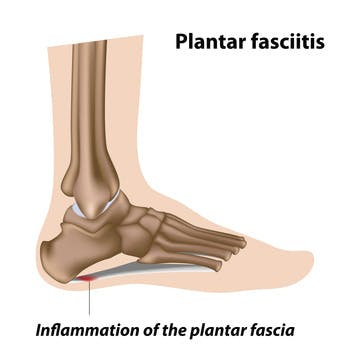If you are looking for plantar fasciitis treatment in Hillsboro or Portland, the information below will help you make a better decision, as well as help you avoid unnecessary and expensive healthcare treatment.
What causes it?
Plantar fasciitis is an inflammation of the plantar fascia which is a thick, wide, ligament-like soft tissue on the bottom of your foot. Aching or sharp pain usually occurs in the inside arches of your foot, and/or sometimes is focused around the bottom aspect of the heel bone. Stretching pain is usually most prominent upon the first step in morning, and usually feels worse the day after bouts of increased walking, running or standing. The plantar fascia runs from your heel bone (calcaneus) down to your toes.
Plantar fasciitis symptoms include sharp pain at the base of your heel that can radiate into the arch of your foot. Sometimes there’s noticeable swelling as well. Folks with both low and high arches can experience this, and is also usually associated with tight calves, and tight achilles tendons. Walking and running in unsupportive shoes may also be a contributing factor.
Causes of plantar fasciitis include:
- A rapid increase in physical activity
- Repetitive motions like distance running
- Limited flexibility of the gastrocnemius and soleus muscles (your calf muscles),
- Poor arch support and/or excessive foot pronation
- Overweight patients are also more likely to develop plantar fasciitis.

What You Need to Know – Don’t Insist on an X-ray Right Away
Over 2 million people experience heel pain each year. It’s a common condition. In many cases, x-rays offer no additional information as to the cause of your pain and as such, are not needed. The first line of action should be conservative care.
Physical Therapy First is Clinically Proven to Help
There are a variety of options for the treatment of plantar fasciitis. We are strong advocates for natural, conservative, hands-on treatment and clinical research support our view:
The guidelines present evidence that strongly suggests a combination of manual therapy and rehabilitative exercises to help patients with this foot condition. In a more recent study published in the February 2017 issue of JOSPT, researchers reviewed the records of people with plantar fasciitis who were sent to physical therapy. The results of this study support prior studies that show faster recovery time for those who receive evidence-based physical therapy for their foot pain.
Reference: https://www.jospt.org/doi/full/10.2519/jospt.2017.0501
What to Do First – See One of Our Plantar Fasciitis Treatment Experts in Beaverton & Hillsboro
If you are experiencing plantar fasciitis, you shouldn’t wait more than a week to see if it gets better on its own. Conservative, natural care, which is what we provide here at our practice, is what you should try first.
The advantages of seeing one of our physical therapy experts are as follows:
- No waiting - In most cases, you can see us right away.
- No side effects – In most cases, the treatment we provide has little to no side effects and can make you feel much better
- It’s more affordable – an average course of treatment
- Seeing one of our physical therapists within 14 days means you’re not likely to need additional care, special tests, injections or surgery
- Seeing one of our physical therapists first means you are less likely to need addictive opioid drugs
Stride Strong PT’s Formula For Treating Plantar Fasciitis

- Delineate offending structure and determine whether pain is truly plantar fasciitis, or neurodynamic dysfunction originating from the spine.
- Manual therapy, stretching and ASTYM to improve soft tissue pliability and decrease pain. ASTYM is a very popular approach with excellent results. It may be uncomfortable at first, but effects and relief are felt immediately. Stretches of calf structures, and self-massage exercises are usually prescribed to make sure the tightening pain is kept at bay. Gluteal/hip strengthening also helps tremendously in treating faulty biomechanics related to the strain of foot arches. Over-pronation is sometimes a culprit, which can be corrected by changing the landing angles of the foot and knee in walking and running. Physical Therapy for plantar fasciitis need not be a long stint of rehab - 4 weeks is the usual timeframe of PT needed for your feet to feel ay-OK again.
- Strengthen gluteal muscles for better loading mechanics during weight-bearing to offset pressure into the foot.
- Taping, orthotics guidance with concurrent modalities to decrease further strain on the foot.
- We can also help arm you with accessories and tools to help in your recovery (e.g., some patients report really good results from using night splints or boots). My personal favorite is The Strassburg Sock.
- In some serious cases, a podiatrist's intervention may be what you need. They will prescribe PT as the first conservative approach and may move into cortisone injections when warranted, or suggest surgery options.
Same-day/Next-Day Appointments are Available.
Check out our closest location near you and call our main line to get started!

